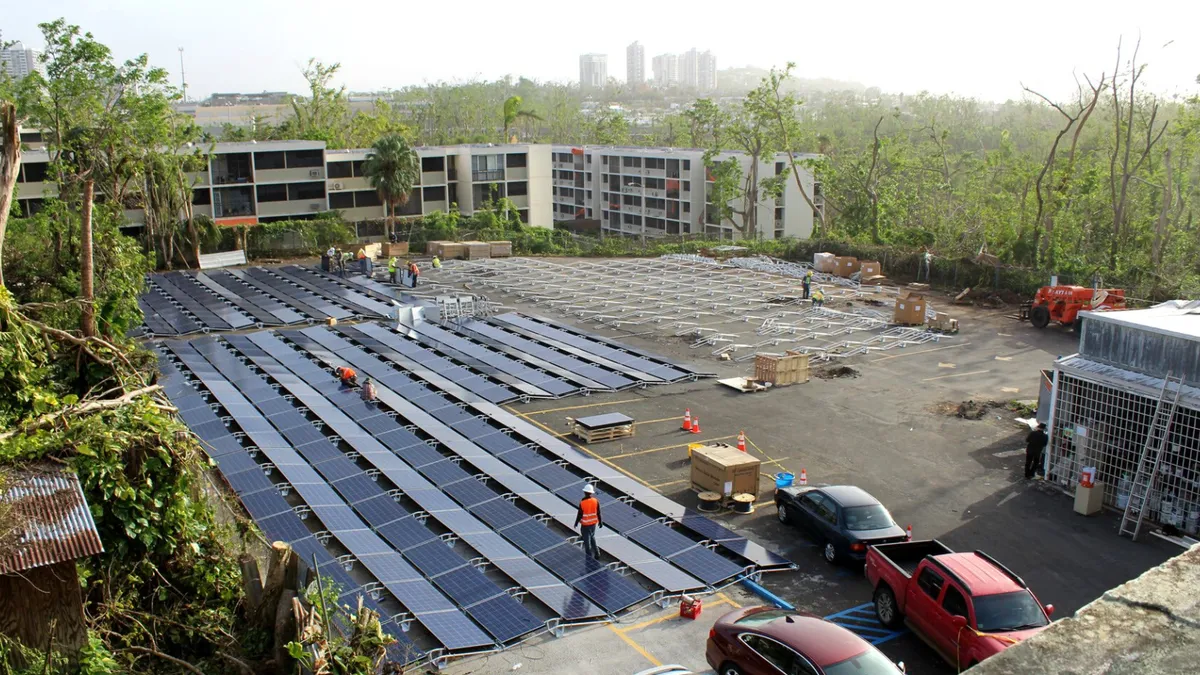Dive Brief:
- Puerto Rico's electric utility on June 7 unveiled its highly-anticipated integrated resource plan, sketching out a 20-year campaign to modernize and reimagine the island's grid, including installing almost 1.4 GW of solar generation and 920 MW of battery storage in the first four years of the overhaul, from 2019 to 2022.
- Hurricane Maria destroyed the Puerto Rico Electric Power Authority's (PREPA) utility grid in 2017, leaving 1.5 million residents without power for months. While the aging grid has been restored, the island is now considering how to reach 100% renewable energy by 2050.
- Prepa's IRP, developed by the strategic advisory and technical consulting arm of engineering giant Siemens, focuses on adding distributed resources and hardening the transmission and distribution grid, breaking down the island's system into "eight largely self-sufficient electric islands" called MiniGrids.
Dive Insight:
Prepa's IRP comes with a price tag north of $14 billion, but the utility's report points to major potential benefits following disruptive storms.
"The business case for transforming the grid architecture is straightforward: it provides the least cost approach to achieve resilience against major hurricanes, meet and exceed compliance with the renewable portfolio standard, engage customers, and lower cost," according to the IRP.
The plan's eight MiniGrids (distinct from micro grids, the utility says) would be capable of islanding following major storms or other events.
"The MiniGrids are designed to ensure continued supply to critical loads (those loads most necessary for the safety and health) and provide timely recovery of the priority loads (those required to regain normalcy and restart the economy) and balance the loads within the MiniGrid," according to the IRP.
In addition to the MiniGrids, the IRP identifies a need for smaller microgrids in areas likely to remain isolated from the main grid for longer periods of time after a major event, due to geography.
Siemens recommended the utility issue requests for proposals, or take other similar paths, to acquire photovoltaic solar in blocks of approximately 250 MW, "with the goal of adding 1,380 MW over the first four years of the plan."
Depending on pricing, battery storage could be acquired alongside solar PV. The IRP calls for 920 MW of battery storage in the first four years, but says this is "heavily correlated" with the needs of individual MiniGrids. The plan recommends storage be added with PV additions, in blocks of 150 MW to 200 MW.
The plan puts Puerto Rico on a path to consume more than two-thirds renewable electricity by 2038, reducing emissions 88% across the plan years.
The IRP also notes energy efficiency and demand response can provide significant flexibility, which is particularly important due to uncertainty with the island's load forecasts. The island faces negative population growth and falling electricity demand, but the report says that could change if federal aid gives a boost to the economy, outmigration reverses or tourism industries increase.
"Declining load growth presents a difficult planning environment that requires PREPA to preserve optionality to develop new resilient resources should load growth be higher than forecast," the IRP says.
The plan calls for load management techniques, concluding efficiency could reduce demand by over 1,900 GWh by 2025, while demand response would add 60 MW of flexibility to the grid in the same time frame.
Along with new solar and battery resources, the IRP calls for retiring older oil-fired units and modernizing the remaining plants to use natural gas as well as diesel.
Siemens acknowledged uncertainty surrounding the development of new gas resources, but recommended moving quickly on procurement even if plans change later.
"There are significant uncertainties in the future related to potential load deterioration, the relative cost trajectory of renewables and storage compared to gas, and the political environment for developing new LNG infrastructure," the report said. "Given the long lead times, it is prudent to start the process for siting and permitting now and make the final decisions for equipment and construction commitments as future events reveal themselves."














